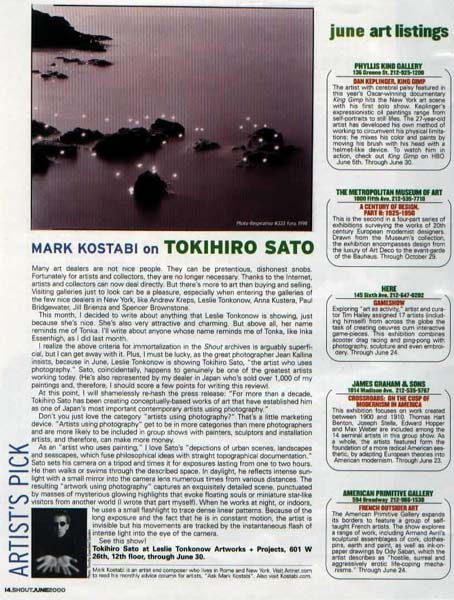Mark Kostabi on Tokihiro Sato

Many art dealers are not nice people. They can be pretentious, dishonest snobs. Fortunately for artists and collectors, they are no longer necessary. Thanks to the Internet, artists and collectors can now deal directly. But there’s more to art than buying and selling. Visiting galleries just to look can be a pleasure, especially when entering the galleries of the few nice dealers in New York, like Andrew Kreps, Leslie Tonkonow, Anna Kustera, Paul Bridgewater, Jill Brienza and Spencer Brownstone.
This month, I decided to write about anything that Leslie Tonkonow is showing, just because she’s nice. She’s also very attractive and charming. But above all, her name reminds me of Tonka. I’ll write about anyone whose name reminds me of Tonka, like Inka Essenhigh, as I did last month.
I realize the above criteria for immortalization in the Shout archives is arguably superficial, but I can get away with it. Plus, I must be lucky, as the great photographer Jean Kallina insists, because in June, Leslie Tonkonow is showing Tokihiro Sato, “the artist who uses photography.” Sato, coincidentally, happens to genuinely be one of the greatest artists working today. (He’s also represented by my dealer in Japan who’s sold over 1,000 of my paintings and, therefore, I should score a few points for writing this review).
At this point, I will shamelessly re-hash the press release: “For more than a decade, Tokihiro Sato has been creating conceptually-based works of art that have established him as one of Japan’s most important contemporary artists using photography.”
Don’t you just love the category “artists using photography?” That’s a little marketing device. “Artists using photography” get to be in more categories than mere photographers and are more likely to be included in group shows with painters, sculptors and installation artists, and therefore, can make more money.
As an “artist who uses painting,” I love Sato’s “depictions of urban scenes, landscapes and seascapes, which fuse philosophical ideas with straight topographical documentation.” Sato sets his camera on a tripod and times it for exposures lasting from one to two hours. He then walks or swims through the described space. In daylight, he reflects intense sunlight with a small mirror into the camera lens numerous times from various distances. The resulting “artwork using photography” captures an exquisitely detailed scene, punctuated by masses of mysterious glowing highlights that evoke floating souls or miniature star-like visitors from another world (I wrote that part myself). When he works at night, or indoors, he uses a small flashlight to trace dense linear patterns. Because of the long exposure and the fact that he is in constant motion, the artist is invisible but his movements are tracked by the instantaneous flash of intense light into the eye of the camera.
See this show!
June 2000